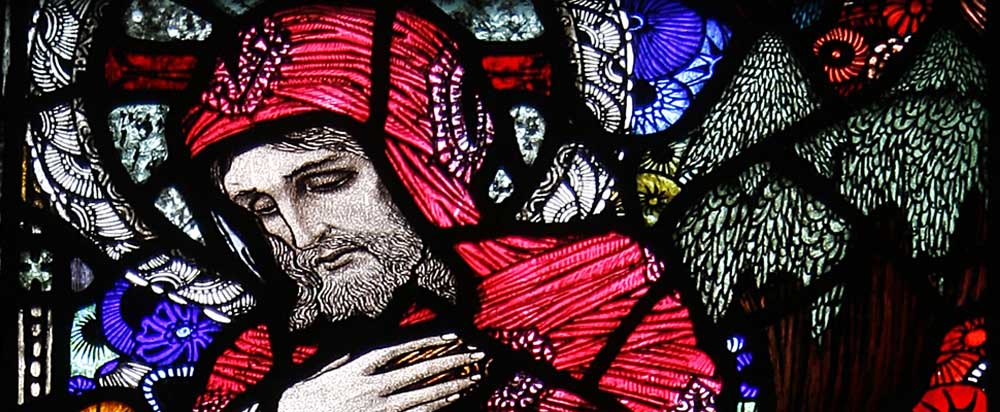The explosive and enigmatic stained glass of Harry Clarke
The artist left a handful of jewels strewn across Ireland, says Michael Duggan
Where the imagery of Christmas is concerned, I am an old fogey. I like to be surrounded by cards bearing paintings of the Holy Family by Old Masters; or, failing that, pictures of robins; or even, if it comes to it, snowy village scenes with a horse-drawn carriage pulled up outside the inn, the church tower looming through the fog, urchins gambolling back and forth, and so on.
And yet I also find myself drawn to the Nativity scenes created in stained glass by the Irish artist Harry Clarke, which often stray quite a long way from familiar styles and formulas.
Clarke was born in Dublin in 1889. His father was a church decorator to whom he became apprenticed when he was only 14, following the death of his mother. Harry went on to become a leading figure in the Irish Arts and Crafts movement. The poet George Russell, aka the pseudonymous “Æ”, called Clarke “one of the strangest geniuses of his time. He might have incarnated from the dark side of the moon”. Clarke died aged just 41, a victim of tuberculosis.
The Nativity scene in the east window in St Barrahane’s in Castletownshend, Co Cork, completed in 1918, is a fine example of Clarke at the height of his powers. It glows with extraordinary colours. The interior of the stable is abstractedly rendered, a controlled riot of patterns and fragments, as if the event that has taken place there had caused some kind of chromatic explosion.
With shepherds, Magi and animals packed into the side lights, the window is dominated by the Holy Family. The posture of each main character is highly stylised and carefully differentiated. The arms of Joseph are arranged so that one is horizontal and the other vertical in the act of holding a lantern. He is standing erect and looms above a kneeling Mary, whose arms are crossed to form an “X”, high up on her chest. Lying in the manger beneath her is Jesus. His arms are flung open against the backdrop of his mother’s ever-extending cloak of intense blue. But even the flinging open of the arms is executed with exactness and precision to form a perfect crescent.
These postures imbue a vibrant tableau with the stillness of geometric shapes. The whole arrangement gets me thinking of the Book of Kells and the famous Chi-Rho page (from the Greek letters used to abbreviate Christ’s name in medieval manuscripts).
The faces too are compelling. Mary’s uncovered hair is bright and fair. She is beautiful with a sallow complexion and large, wide, almond-shaped eyes. For Irish people of a certain age, she calls to mind the painting of Lady Lavery that once appeared on our banknotes as a female personification of the nation.
Joseph cuts an even more striking figure. His fingers are extraordinarily long and delicate, like tapering rose stems. These are emphatically not the hands of a carpenter. He wears a tight-fitting, embroidered skullcap with flaps extending down over the ears. His face and expression are inscrutable, Asiatic, Confucian even. And the curlicues of his beard twist and fold like patterns that have also escaped from the Book of Kells. The infant Christ’s features resemble those of his mother. There is even a touch of reddishness to his hair.
It is a strange, ethereal, mesmerising work of art. And there are plenty more like it. Further west from Castletownshend, in Dingle, Co Kerry, The Visit of the Magi is a similarly stunning piece. Christ’s hair is by now undeniably full and red, while Mary’s has turned dark. The trademark eyes, “sad and entreating”, as they have been called, remain.
In the words of one writer, “the windows of Harry Clarke are like jewels, strung out across Ireland.” Admirers of Clarke in Britain, though, should probably beat a track to St Mary’s in Sturminster Newton, Dorset. In a recently published guide to the church windows of England, stained-glass expert Jane Brocket heaps praise on Clarke’s achievements. His depiction of St Elizabeth of Hungary she judges to be “one of the most stunning and unusual” of its kind.
Brocket is enchanted by the more secular features of Clarke’s design: the “gorgeous” shoes, the “fabulous” mix of coutures. Clarke carried out many commissions away from churches, often based on themes from folklore and Romantic literature. These pieces provide much to admire, but, for my part, I prefer the religious work where the great but earthy scenes of the Incarnation prevent Clarke from drifting too far into Celtic or other twilights.
But they challenge me too, not least my desire for the comforts of a conventional Christmas. Perhaps that is, in part, the point: to remind us once more of the utter strangeness of the event that we are used to celebrating in fond, familiar ways.

No comments:
Post a Comment